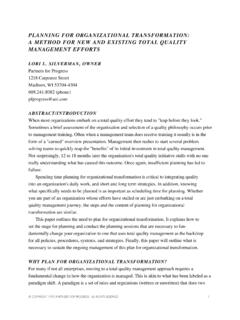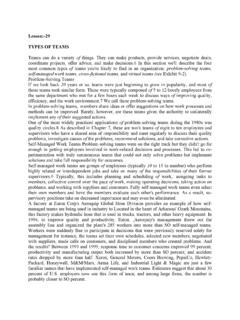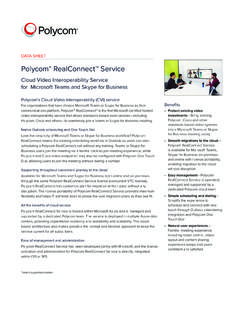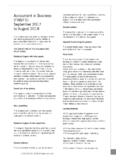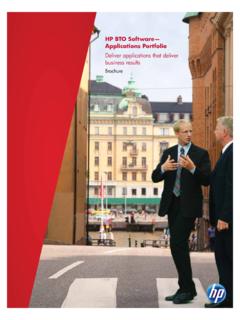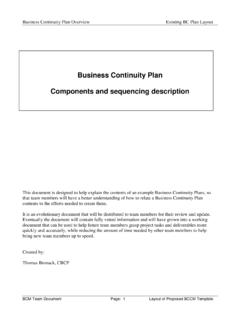Transcription of ENSURING SUCCESS: A MODEL FOR SELF …
1 COPYRIGHT 1996 PARTNERS FOR PROGRESS AND FULLER & PROPST ASSOCIATES. ALL RIGHTS RESERVED. 1 ENSURING success : A MODEL FOR self - managed TEAMS LORI L. SILVERMAN ANNABETH L. PROPST Partners for Progress Fuller & Propst Associates 19202 N. 31st Drive 41W202 Whitney Road Phoenix, AZ 85027 USA St. Charles, IL 60175, USA +1 623 516 4932 office INTRODUCTION Over the past few years, there has been much talk about the benefits of self - managed teams (also known as self -directed teams, natural teams, or semiautonomous work groups). Everyone seems to want some form of them in their organization.
2 A number of books and articles have been written on the subject since they were first introduced in the 1940s as a method of employee involvement. They typically list the activities and steps the organization should follow to develop self - managed teams, outline the skills required of team leaders and team members, and describe the phases an organization goes through to achieve its objective of employing self - managed teams. These books and articles contain good ideas and useful information, yet many organizations do not have fully functioning self - managed teams. Why is this? We believe it is due, in part, to the lack of a MODEL that describes the roles of self - managed teams within organizations.
3 This paper introduces such a MODEL that includes the following roles: Uphold organizational and personal values and principles; Accomplish the team s work; Organize the team s work environment; Manage the team s work processes; Participate in organization-wide systems; Participate in organization-wide strategies; and Manage team processes. The types of responsibilities that are a part of each role and how each role fits within the overall work of the organization are detailed here. In addition, we provide steps for introducing your organization and your work group to this MODEL .
4 WHAT IS A self - managed team ? Even though the terms self - managed and self -directed are used frequently, they are rarely defined. As several authors have noted, there is no such thing as a typical self - managed team COPYRIGHT 1996 PARTNERS FOR PROGRESS AND FULLER & PROPST ASSOCIATES. ALL RIGHTS RESERVED. 2 (Holpp, 1993, Shonk, 1992). Yet, it has been our experience that having a common definition can serve as a framework for discussion and dialogue on this topic. In 1990, Development Dimensions International, the Association for Quality and Participation, and Industry Week conducted a study on the current practice surrounding self -directed teams.
5 The study defined a self -directed team as a group of employees who have day-to-day responsibility for managing themselves and the work they do. Members of self -directed teams typically handle job assignments, plan and schedule work, make production-related decisions, and take action on problems. Members of self -directed teams work with a minimum of direct supervision. As such, the teams are not quality circles or cross-functional task groups.. [T]hese teams are characterized by: Face-to-face interaction in natural work groups; Responsibility for producing a definable product; Responsibility for a set of interdependent tasks; and Control over managing and executing tasks.
6 (page 4) This definition outlines the end state to which work groups evolve when they finally become self - managed teams. However, organizations also need to understand the process surrounding how teams become self - managed over time. Zawacki and Norman (1994) suggest that successful self - managed teams evolve through five stages. These are: Stage 1: The typical hierarchical structure where the leader provides one-on-one supervision; Stage 2: The leader evolves into a group manager whose role is making the transition into team coordinator/coach; Stage 3: The group manager becomes the team coordinator and provides a structure for self - managed team members to receive the necessary training to take on more leadership tasks; Stage 4: The team assumes most of the duties previously reserved for the group manager, who now becomes a boundary interface.
7 And Stage 5: The group manager ( , the team coordinator) is a resource for the team . We concur with Zawacki and Norman (1994) that a typical organization can have self - managed teams in each of these five stages at various times. Teams can (and will) revert back to earlier stages as team membership changes over time. In addition, it is our experience that a team may operate in a different stage in each of the seven roles. For example, a team could be performing Stage 3 responsibilities within the role accomplishing the work and Stage 1 responsibilities within the role participating in organization-wide strategies.
8 WHY USE self - managed TEAMS? What rationale does an organization use to encourage its teams to move from Stage 1 through to Stage 5? First and foremost is the desire to promote customer satisfaction. As a team moves COPYRIGHT 1996 PARTNERS FOR PROGRESS AND FULLER & PROPST ASSOCIATES. ALL RIGHTS RESERVED. 3 toward Stage 5, members typically receive customer requirements and feedback directly, rather than filtered through a supervisor. team members are also able to use this first-hand information to respond appropriately to customers and thus continually increase their own learning over time.
9 In addition, the cycle time for making on-the-spot customer-related decisions is shortened. A second reason organizations move toward self - managed teams is the desire to promote employee satisfaction. Human potential has the opportunity to be cultivated and exercised to its fullest extent as team members take on additional roles and responsibilities. Finally, moving teams from Stage 1 to Stage 5 allows organizations to be more proactive. It releases individuals from first-line supervisor roles that are typically reactive in nature and frees them up to engage in future-oriented work that encourages organizational growth.
10 From our perspective, an inappropriate rationale for initiating self - managed teams is the removal of a layer of management as a means of cost containment. If this is the case, then senior management needs to be educated on the future role of today s first-line supervisors that we believe is more closely related to the other side of the profitability equation, that is, the production of revenue. Although we recognize the potential value of self - managed teams, it is also important to keep in mind that self -management is not an appropriate objective for all work groups in all organizations.


